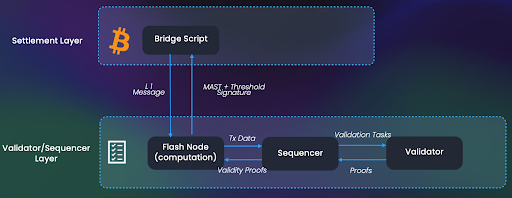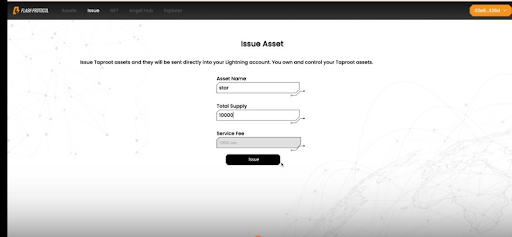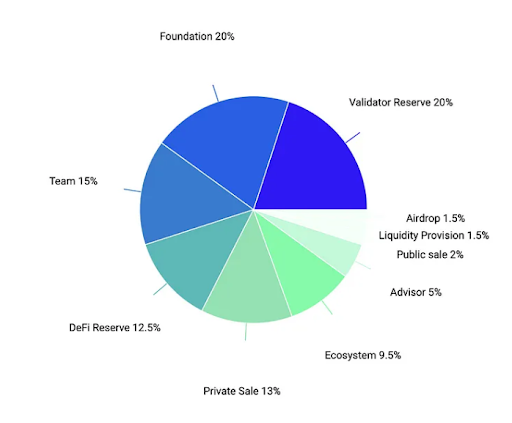Flash Protocol (FLASH): Bridging Bitcoin and DeFi With Taproot
In late 2021, Bitcoin (BTC) underwent a crucial update called Taproot. One of the most notable updates in Bitcoin's history, Taproot made it possible to batch together multiple Bitcoin transactions and signatures, significantly improving the efficiency and speed of the on-chain validation process. Thanks to batching together multiple signatures, Taproot also made Bitcoin a more private environment. The efficiency and privacy gains, in turn, opened up opportunities for new use cases on the Bitcoin network, including in the area of decentralized finance (DeFi).
Flash Protocol (FLASH), one of the projects aiming to leverage the opportunities created by Bitcoin Taproot, supports the issuance, management and liquidity applications for native Bitcoin assets. It's one of the most innovative projects dedicated to Bitcoin DeFi, or BTCFi, as it's customarily known.
The project's decentralized protocol allows you not only to issue and own native Taproot assets but also to use them in various asset liquidity applications. Thanks to Flash, Bitcoin native assets are no longer limited to simple transfers and value storage.
Key Takeaways:
Flash Protocol (FLASH) is a decentralized platform that facilitates the fast and cheap issuance, management and BTCFi applications of Bitcoin Taproot native assets.
At the core of the protocol are the Bitcoin-linked Layer 1 network, Flash Chain, and the FlashVM computational engine that powers the chain's operations.
What Is Flash Protocol?
Flash Protocol (FLASH) is a blockchain platform that facilitates the issuance and management of native Bitcoin assets of both fungible and non-fungible varieties at high transaction speed and low cost. Taking advantage of Bitcoin's Taproot update, Flash Protocol introduces new use cases for digital assets native to Bitcoin, including BTCFi, a newly developing niche of DeFi applications for the Bitcoin ecosystem.
The Flash Protocol team has announced the key components of its platform, the Bitcoin-linked Flash Chain and the computational engine that powers it, FlashVM. The project launched its native token, FLASH, on its crowdfunding platform, BTC Angel Hub, on March 29, 2024.
Based on the information provided by the protocol, Flash Chain will operate as a network that facilitates the minting, transfers and use of native Bitcoin assets, both non-fungible tokens (NFTs) and fungible crypto tokens. Notably, the Flash Protocol focuses on Taproot assets, which use MAST (Merklized Abstract Syntax Trees) to enable smart contracts and Schnorr signatures that facilitate efficiency, scalability and privacy. This focus is crucial in empowering Bitcoin to overtake Ethereum as the smart contract chain of choice, since the more popular development of BRC-20inscriptions has resulted in network congestion on Bitcoin with the influx of meme coins with no inherent uses.
The platform's ecosystem will feature the first NFT mint protocol for Taproot assets, an order book–style decentralized exchange (DEX) and support for Lightning Network — one of Bitcoin's most popular scalability solutions.
How Does Flash Protocol Work?
At the core of Flash Protocol are its decentralized network, Flash Chain, and the FlashVM computational engine.
FlashVM
FlashVM is a smart contract–capable engine that powers the functionality of Flash Chain and acts as a bridge between Bitcoin and Flash Chain to facilitate a Bitcoin-native ecosystem. Thanks to its ability to support smart contracts, FlashVM will open up avenues for using protocol-based assets in DeFi solutions, extending their functions beyond simple transfers and storage. In general, the smart contracts are executed off-chain on the Flash Chain, with the computations only published on-chain on Bitcoin itself in the event of a dispute.
FlashVM is structured into two layers — the Settlement Layer and Validator/Sequencer Layer. The Settlement Layer leverages Bitcoin's robust security and finality, creating a secure bridge between Bitcoin and Flash Chain using technologies like Bridge Script, MAST and threshold signatures. Below this, the Validator/Sequencer Layer handles transaction computation and indexing, in which Flash Nodes process transactions and generate execution traces, and validators work with coordinators to prove transactions. This layer is crucial for FlashVM's consensus mechanism and overall network security.
Flash Chain
Flash Chain is a proof of stake (PoS) Layer 1 chain that enables BTCFi operations and manages Taproot assets. Since FlashVM is built into the Flash Chain, users can freely create smart contracts on the Flash Chain by staking FLASH tokens, which could lead to a proliferation of BTCFi applications.
The primary functions supported by Flash Chain will include:
Cost-effective and 100% permissionless NFT and fungible asset issuance
A marketplace designed specifically for asset liquidity enhancements
Activities such as staking, lending and borrowing, tailored to the Bitcoin DeFi space
Flash Protocol Key Features
To start using the Flash’s services, you'll first need to connect one of the supported wallets — OneKey, Wallet of Satoshi, Phoenix or Alby. You'll also need some satoshis loaded into the wallet via Lightning Network to have enough funds for a small initial deposit.
Asset Issuance
After depositing a small amount in satoshis (e.g., 1,000 satoshis, which is equal to 0.00001 BTC) via Lightning Network, you’ll be able to start using the protocol’s user interface where all the main functions are conveniently listed. Simply select the Issue tab on the interface if you'd like to mint your custom fungible asset.
You'll then need to provide just two basic details for your token — its name and total supply.
Taproot NFT Minting
Flash Protocol offers a way to mint Taproot NFTs, which are tamperproof thanks to Bitcoin's security. The project's documentation specifies a procedure that allows you to mint an NFT by selecting one of the many pre-made designs. It's possible that, in the future, the protocol will introduce the functionality to mint an NFT based on your own artwork.
BTC Angel Hub
BTC Angel Hub is Flash Protocol's crypto crowdfunding platform, focusing on GameFi, artificial intelligence (AI) and meme coin projects. Operators looking for funding can list their projects on the platform after the protocol's team reviews and accepts their applications. Those looking to support Taproot-focused initiatives can review the details of the projects listed on the hub.
Explorer
Accessible via a tab on the platform's main interface, Flash Protocol’s Explorer will allow you to view details of all transactions processed by the protocol. Data on deposits, incoming and outgoing transfers, fungible and non-fungible asset issuance and more will be available via the explorer.
Flash Protocol Tokens
The protocol's ecosystem will include two crypto assets: FLASH and FLAI. The former is the platform's main native crypto.
FLASH
FLASH, currently priced at $0.0003, is a fully community-owned, deflationary token with a maximum supply of 10 billion and total supply of 825 million, with cyclical burn and rebase mechanisms. This ERC-20 token is designed to function as Flash Chain’s native crypto, facilitating the payment of network transaction fees. A portion of transaction fees will be distributed to FLASH token holders. FLASH will also be used to reward validator nodes for securing network operations, as well as for governance. Token holders will be a part of the Flash Protocol DAO, and will have to stake their tokens to vote on proposals. Voting power will be proportional to the total amount of tokens staked.
Flash Protocol's airdrop campaign, which comprises 1.5% of its supply, was split into three parts — the Zealy campaign, the Pilot NFT campaign and an airdrop for Elfin Land minters. It concluded at the end of March 2024, with the airdrop supply fully distributed on the day of the token launch. Its maximum supply is being distributed as follows:
FLAI
The protocol's second crypto asset, FLAI, is an ERC-20 token that can be minted as an inscription on Bybit Web3. The protocol's team announced in March 2024 that FLAI will be call option–exchangeable with FLASH tokens, indicating that the token's main use will be within certain BTCFi applications powered by the platform.
Closing Thoughts
Many traders dream of using their Bitcoin in DeFi. At the same time, few platforms support truly multi-functional, full-scale BTCFi applications. Flash Protocol is among the pioneers in this area, with interesting offerings such as NFT and fungible asset issuance, DEX trading and a liquidity marketplace. Using the opportunities presented by Bitcoin's Taproot update, Flash Protocol promises a completely new world for investors, traders and NFT enthusiasts.
All that remains now is for the protocol to launch in full-scale, public mode so that members of the Bitcoin community can make their choices. Will Flash Protocol have as much impact on the world of Bitcoin as Ordinal NFTs or BRC-20 tokens have had? Possibly. Right now, the innovations and services promised by the protocol's team look very impressive. Let's see how much of this potential will be realized when Flash Chain is unveiled.
#LearnWithBybit




